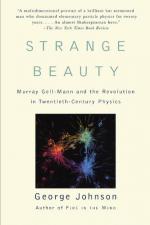|
This section contains 733 words (approx. 3 pages at 300 words per page) |

|
Encyclopedia of World Biography on Murray Gell-Mann
The American physicist Murray Gell-Mann (born 1929) coined the definition "quarks" to describe the triplets of particles that form the cores of atoms. The Nobel Prize winner for physics in 1969, he helped to develop the Stanford model, which describes the behavior of subatomic particles and their forces.
Murray Gell-Mann was born on September 15, 1929, in New York City of Austrian immigrant parents. A precocious child, he attended a special school for gifted children, where he took a physics course. "It was the dullest course I've ever taken," he told Omni magazine in 1985, "and the only course I've ever done badly in!"
Early Academic Career
Gell-Mann graduated from school at the age of 15 and entered Yale University, where he sailed through a bachelor's degree to earn his diploma in 1948. Next came graduate study at the Massachusetts Institute of Technology (MIT), where he claims to have found out, for the very first...
|
This section contains 733 words (approx. 3 pages at 300 words per page) |

|


